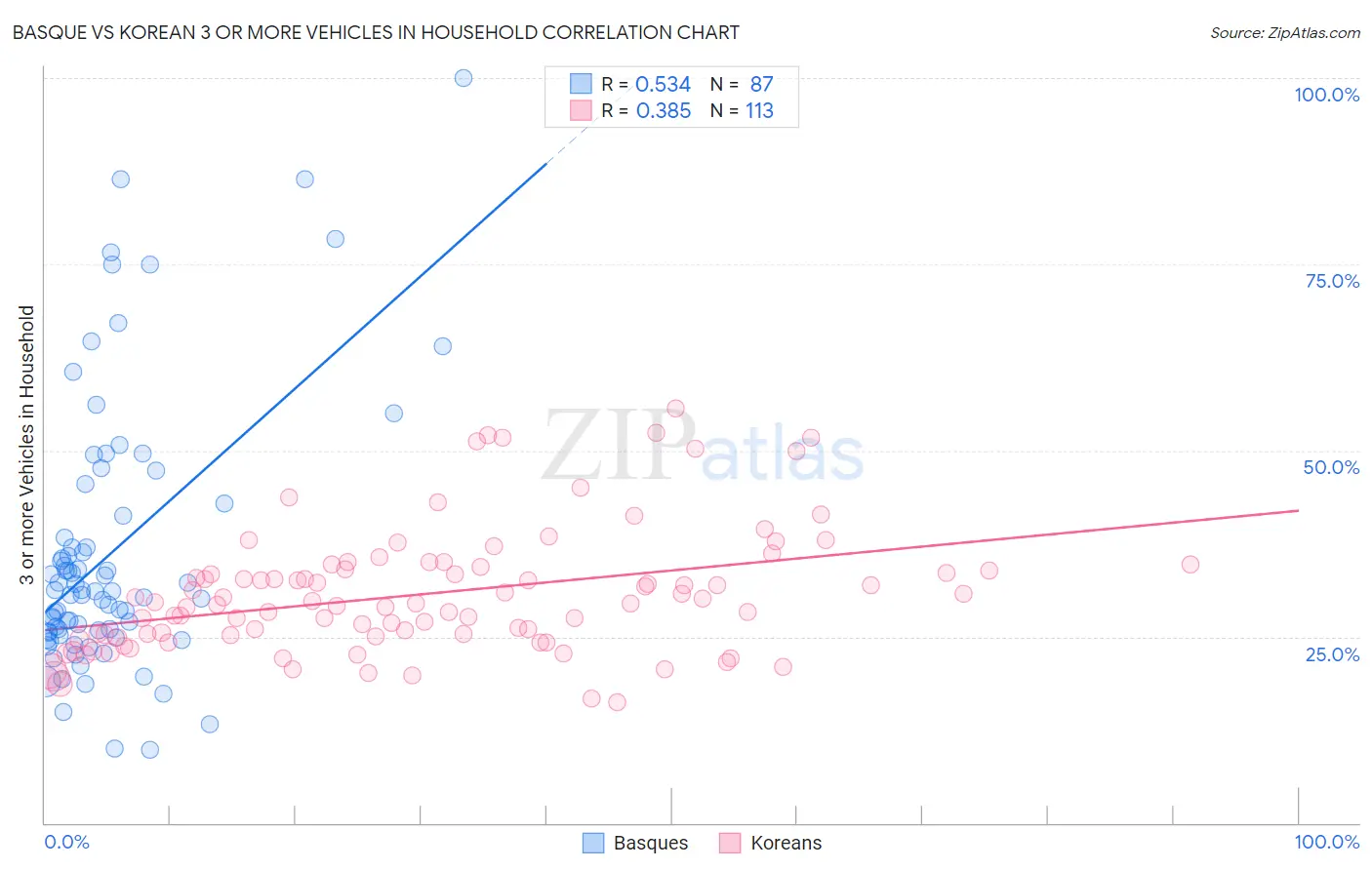Basque vs Korean 3 or more Vehicles in Household
COMPARE
Basque
Korean
3 or more Vehicles in Household
3 or more Vehicles in Household Comparison
Basques
Koreans
24.3%
3 OR MORE VEHICLES IN HOUSEHOLD
100.0/ 100
METRIC RATING
16th/ 347
METRIC RANK
24.1%
3 OR MORE VEHICLES IN HOUSEHOLD
100.0/ 100
METRIC RATING
17th/ 347
METRIC RANK
Basque vs Korean 3 or more Vehicles in Household Correlation Chart
The statistical analysis conducted on geographies consisting of 165,726,625 people shows a substantial positive correlation between the proportion of Basques and percentage of households with 3 or more vehicles available in the United States with a correlation coefficient (R) of 0.534 and weighted average of 24.3%. Similarly, the statistical analysis conducted on geographies consisting of 510,183,740 people shows a mild positive correlation between the proportion of Koreans and percentage of households with 3 or more vehicles available in the United States with a correlation coefficient (R) of 0.385 and weighted average of 24.1%, a difference of 0.80%.

3 or more Vehicles in Household Correlation Summary
| Measurement | Basque | Korean |
| Minimum | 9.9% | 16.2% |
| Maximum | 100.0% | 55.6% |
| Range | 90.1% | 39.4% |
| Mean | 36.3% | 30.8% |
| Median | 31.1% | 29.4% |
| Interquartile 25% (IQ1) | 25.6% | 25.1% |
| Interquartile 75% (IQ3) | 41.2% | 34.2% |
| Interquartile Range (IQR) | 15.6% | 9.1% |
| Standard Deviation (Sample) | 18.1% | 8.3% |
| Standard Deviation (Population) | 18.0% | 8.2% |
Demographics Similar to Basques and Koreans by 3 or more Vehicles in Household
In terms of 3 or more vehicles in household, the demographic groups most similar to Basques are Hawaiian (24.3%, a difference of 0.030%), Immigrants from Mexico (24.6%, a difference of 1.4%), Norwegian (23.9%, a difference of 1.6%), Chinese (23.9%, a difference of 1.6%), and Mexican (24.7%, a difference of 1.8%). Similarly, the demographic groups most similar to Koreans are Norwegian (23.9%, a difference of 0.79%), Chinese (23.9%, a difference of 0.82%), Hawaiian (24.3%, a difference of 0.83%), Paiute (23.8%, a difference of 1.1%), and Immigrants from Vietnam (23.8%, a difference of 1.2%).
| Demographics | Rating | Rank | 3 or more Vehicles in Household |
| Immigrants | Fiji | 100.0 /100 | #6 | Exceptional 26.1% |
| Colville | 100.0 /100 | #7 | Exceptional 25.8% |
| Samoans | 100.0 /100 | #8 | Exceptional 25.0% |
| Native Hawaiians | 100.0 /100 | #9 | Exceptional 24.9% |
| Nepalese | 100.0 /100 | #10 | Exceptional 24.9% |
| Shoshone | 100.0 /100 | #11 | Exceptional 24.9% |
| Danes | 100.0 /100 | #12 | Exceptional 24.7% |
| Mexicans | 100.0 /100 | #13 | Exceptional 24.7% |
| Immigrants | Mexico | 100.0 /100 | #14 | Exceptional 24.6% |
| Hawaiians | 100.0 /100 | #15 | Exceptional 24.3% |
| Basques | 100.0 /100 | #16 | Exceptional 24.3% |
| Koreans | 100.0 /100 | #17 | Exceptional 24.1% |
| Norwegians | 100.0 /100 | #18 | Exceptional 23.9% |
| Chinese | 100.0 /100 | #19 | Exceptional 23.9% |
| Paiute | 100.0 /100 | #20 | Exceptional 23.8% |
| Immigrants | Vietnam | 100.0 /100 | #21 | Exceptional 23.8% |
| Immigrants | Philippines | 100.0 /100 | #22 | Exceptional 23.8% |
| Scandinavians | 100.0 /100 | #23 | Exceptional 23.6% |
| Sri Lankans | 100.0 /100 | #24 | Exceptional 23.6% |
| Immigrants | Central America | 100.0 /100 | #25 | Exceptional 23.4% |
| Mexican American Indians | 100.0 /100 | #26 | Exceptional 23.3% |